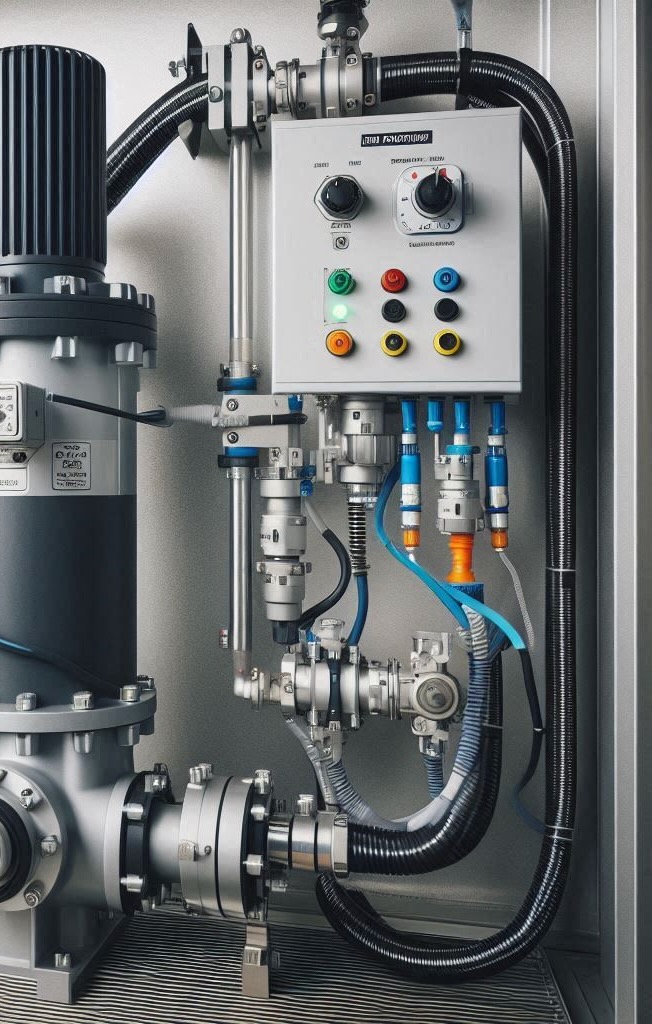
We want to familiarize you with the principles of machine building to expand your knowledge of the field in which we specialize. Our goal is to explain complex principles in the field of industrial mechanical engineering and automation.
Pneumatic systems play a key role in the automation of industrial processes, providing precise and efficient control of various machine components. Understanding the basics of their design and operating principles is essential to ensure the safe and reliable operation of the entire system. In this article, we will introduce you to the most important components of pneumatic systems, their functions and applications, as well as discuss which safety measures must be implemented to meet the requirements of the Machinery Directive.
What is the Machinery Directive?
The Machinery Directive (2006/42/WE) is a European regulation to ensure that machinery placed on the EU market is safe for users and the environment. It covers a wide range of requirements for the design, manufacture, and conformity assessment of machinery.
Key safety requirements
The Directive requires that machinery be designed and constructed in such a way that:
- Minimize usage risks.
- Protect operators from injury.
- Meet specific standards for noise, vibration, and emissions.
Therefore, the compressor room where the compressor is located must be equipped with additional elements to prepare the air for forwarding. These include dryers that remove excess moisture, filters that eliminate solid and oil contaminants, and condensate separators that separate and drain condensed water. Thanks to the use of these devices, the compressed air generated is properly cleaned and dried, which ensures its high quality and reliability in further production processes.
Design principles for safe pneumatic systems
The design of safe pneumatic systems in accordance with the Machinery Directive includes:
- Risk analysis: Identification and assessment of potential hazards.
- Risk reduction: Implement technical and organizational measures to minimize risks.
- Documentation: Maintaining detailed design documentation and conformity assessment.
What is included in the pneumatic system.
Air service station – the most important part of the system
- Manual master valve: responds to the conscious and manual application of pressure to the machine. The valves are equipped with the possibility of securing using the LOTO system. LOTO system – it is a health and safety protection in the event of work carried out on the mass. By closing the valve and securing it with the LOTO system, the mechanics servicing the machine can be sure that no one will accidentally start the machines or lines during the work they are carrying out.
- Air filters: Remove pollutants from the air of a certain size.
- Dehumidifiers: Remove residual water directly in front of the machine, preventing corrosion and damage to pneumatic components. In the dryer, you can see whether the air prepared in the compressor is properly prepared and dehumidified.
- Pressure regulators: Maintain a stable air pressure set and recommended for a given line machine by the manufacturer.
- Electric Main Valve: Responsible for releasing pressure from the machine when the safety system is activated.
Controls
Valves:
- Single valves: serving one valve with individual pneumatic connection and control.
- Valve terminals: a set of valves with one electrical and pneumatic connection to support a module or the entire machine.
The valves are controlled in a way that
- electric – found in automatic machines. Most often controlled by a PLC.
- manual – used in simple assembly stations, operated by the operator. A good example is the operator‘s control of individual elements of the excavator arm (admittedly the hydraulic system)
- pneumatically – these are valves used for indirect control, e.g. a small electrically operated valve is used to start the flow in a valve with a high flow (it plays the role of a pilot initiating the flow).
- Valve types: normally open, closed, vented, aerated
- Functional: 3/2, 5/3, 5/2, 2/2, 2×3/2 ect.
- Throttling–feedback: with manual flow rate setting
- Controlled: Prevents the actuator from moving in the event of a broken hose or a leak in the system.
-
Proportional valves: allow precise control of airflow. With the ability to regulate the flow continuously and in proportion to the control signal, these valves are used in a variety of industrial applications requiring high precision and dynamic control.
Elementy wykonawcze
- Basic: Rectilinear piston movements.
- Rodless: Movement without direct piston.
- Rotary: Rotary motion instead of linear.
Other less common and specialized elements, such as:
- pneumatic motors,
- Screwdrivers,
- Grinders,
- paint guns,
- adhesive systems.
In industry, the most commonly used cables are:
- Polyurethane (PU): Highly flexible, abrasion resistant, ideal for applications in dynamic systems where high flexibility is required. Polyurethane hoses are most often used when welding or welding elements are close to assembly. In places where resistance to falling welding sparks is necessary.
-
Polyamide (PA): They have high mechanical and thermal strength, resistant to oils and chemicals, used in high–pressure applications.






